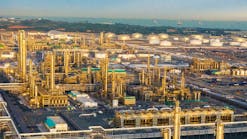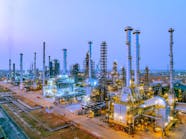Tesoro, Par Pacific refineries agree to further reduce emissions
Robert Brelsford
Downstream Technology Editor
Tesoro Corp. and Par Pacific Holdings Inc. have reached an agreement with US regulators under which the companies will spend a combined $425 million to settle past violations of the Clean Air Act (CAA) and reduce future air pollution from six US refineries.
As part of the agreement, the firms have agreed to invest $403 million to install and operate advanced pollution control equipment and technologies at refineries in Alaska, California, Hawaii, North Dakota, Utah, and Washington to protect surrounding communities from further toxic air emissions from those operations, the US Environmental Protection Agency and the US Department of Justice said.
Lodged in US District Court for the Western District of Texas, the July 18 consent decree requires Tesoro to pay all applicable fines and penalties agreement, including a total civil penalty of $10.45 million divisible among federal and state governments to resolve a range of alleged CAA violations occurring at the refineries, all six of which belonged to Tesoro prior to Par Pacific's purchase of the Kapolei, Ha., refinery in 2013 (OGJ Online, Sept. 27, 2013).
In addition to the civil penalty, the agreement stipulates that Tesoro must invest $12.2 million to improve public health in communities previously impacted by pollution from operations via three environmental projects, including:
• Installation of infrared gas-imagining cameras at its refineries in Anacortes, Wash.; Kenai, Alas.; Mandan, ND; and Salt Lake City, Utah, that will be used to locate fugitive emissions of volatile organic compounds (VOC) to plan for and execute corrective actions to address emissions ($400,000).
• Installation and subsequent performance testing of ultralownitrogen oxide (NOx) burners on the ultraformer furnace at its Salt Lake City refinery to establish a NOx limit for this unit, which will be used to reduce NOx emissions from the unit by about 11 tonnes/year ($10.8 million).
• Contribution of funds to a school district in Contra Costa County, Calif., that will enable replacing a minimum of four diesel-fueled school buses with new compressed natural gas buses to help decrease emissions of NOx, sulfur dioxide (SO2), particulate matter (PM), greenhouse gases (GHG), and other air pollutants ($1 million).
Alongside reducing GHG emissions from flaring at the refineries by more than 60% from current levels, the government agencies said they expect new controls and requirements under the consent decree, once fully implemented, will reduce the facilities' emissions of pollutants as follows: NOx by 407 tpy; SO2 by 773 tpy; VOCs by 1,140 tpy; hazardous air pollutants by 27 tpy; hydrogen sulfides (H2S) by 20 tpy; and GHGs (as CO2 equivalent) by 47,034 tpy.
Par Pacific, which currently is executing routine maintenance at the Kapolei refinery, has expanded the scope of its scheduled turnaround to undertake additional capital improvements aimed at advancing the plant's compliance with requirements of the consent decree. The expanded turnaround is to include: improvements to reduce emissions of air pollutants, improvements to provide for certain NOx and SO2-emission controls and monitoring, and installation of certain leak detection-and-repair equipment.
In addition to work related to installation and improvement of flare-gas recovery and enhanced leak detection-and-repair systems at all six refineries, the agreement requires Tesoro and Par Pacific operating units to comply with refinery-specific mandates, a selection of which follows:
Tesoro Alaska Co. LLC's Kenai refinery: upgrade of H2S or total-sulfur continuous monitoring system for main refinery flare and refinery fuel gas systems; installation of one or more aboveground storage tank(s) sufficient to replace the capacity of the API canals; reporting of each acid-gas flaring event with information related to the event, including its cause as well as available measures to reduce likelihood of its recurrence; and installation of an ambient SO2 monitoring system as well as continuous measurement and reporting of ambient SO2 concentrations in the event three acid-gas flaring events occur within any 12-month period.
TRMC's Martinez, Calif., refinery: at the fluid catalytic cracking unit (FCCU), final NOx emission limits of 40 ppm on a 7-day rolling average basis and 20 ppm on a 365-day rolling average basis; a CO-emission limit of 180 ppm on a 365-day rolling average basis; and NOx continuous emissions monitoring systems on stack to demonstrated compliance with NOx limits; at the delayed coker, a drum-depressurization standard of 2 psig and quench-cycle requirements, including restrictions on quench-water quality and feed as well as quench-water fill time of at least 5 hr/cycle, to control VOCs and other pollutants; at the delayed coker, at least 30-ft walls surrounding the coke pit to control PM; at the sulfuric acid plant (SAP), SO2-emission limits of 1.85 lb/tonne of sulfuric acid produced on a 3-hr rolling average basis and 1.7 lb/tonne produced on a 365-day rolling average basis, as well as implementation of monitoring and operation-and-maintenance plans; and at the sulfur recovery plant (SRU), optional routing of sulfur-pit emissions from SRU to SAP, subject to SAP limits.
Par Hawaii Refining LLC's Kapolei refinery: on 11 heaters and boilers, implementation of NOx limits along with either ultralow-NOx burners or flue gas recirculation; for all heaters and boilers, restriction of fuel oil burning in combustion units to control SO2; installation of NOx continuous emissions monitoring systems; upgrading or replacement of H2S continuous monitoring systems; and implementation of an operation-and-maintenance plan for the systems; and at the SRU, SO2-emission limit of 180 ppm on a 365-day rolling basis; implementation of SO2 continuous emissions monitoring systems; and implementation of an operation-and-maintenance plan for those systems.
TRMC's Mandan refinery: at the FCCU, execution of annual PM stack testing at the unit; development of a comprehensive continuous monitoring system operation-and-maintenance plan that is designed to enhance the per-formance of system components, improve system accuracy and stability, and minimize periods of system downtime; and execution of a continuous monitoring system root-cause failure analysis as well as development of a downtime corrective-action plan for any continuous monitoring system having a downtime of more than 5% of the total time for each of two consecutive calendar quarters.
TRMC's Salt Lake City refinery: at the FCCU, installation of a nonregenerative wet-gas scrubber as well as either a LoTOx system or equivalent-NOx control technology on the unit; at the FCCU, NOx-emission limits of 20 ppm on a 7-day rolling average basis and 10 ppm on a 365-day rolling average basis; SO2-emission limits of 18 ppm on a 7-day rolling average basis and 10 ppm on a 365-day rolling average basis; and CO-emission limits of 500 ppm on a 1-hr block average and 100 ppm on a 365-day rolling average; and at the FCCU, installation of NOx, SO2, and CO continuous emissions monitoring systems to demonstrate compliance.

